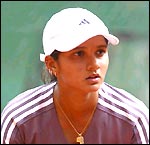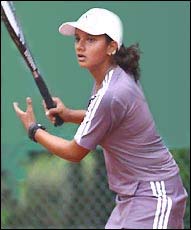'Playing in India doesn't help a lot at the moment'
The Rediff Interview / Sania Mirza
Nagraj Gollapudi
Sania Mirza sits uncomfortably at one end of the couch. It is a typical day in Mumbai - humid with the rains refusing to come down and provide any respite. A sudden bout of cold has attacked her from nowhere and she is sneezing, huffing and puffing and finding it tough to even talk.
 "I don’t know how it came. Till yesterday night I was fine," says Sania, barely able to get the words out. Tired from the morning flight from Hyderabad and irritated by the cold she would well do without.
"I don’t know how it came. Till yesterday night I was fine," says Sania, barely able to get the words out. Tired from the morning flight from Hyderabad and irritated by the cold she would well do without.
However, once the topic shifts to tennis, the pain begins to take a back seat and a smile surfaces on her youthful face. Sania is on her way to New York, to play her second US Open Juniors [she lost in the first round] and is staying at her mother's best friend's house. A thin waft of breeze passes across the Marine Drive appartment. It is relaxing. Being the country's top junior women's player consistently for the last couple of years now, Sania has just been displaced off the top rung of the ladder by another talented youngster, Isha Lakahani, who is at a career high 28, while Sania is five rungs below, at 33.
"Well, I myself was at 27 in January 2002," comes a quick retort. Sitting next to her, Naseem Mirza, Sania’s mother and travelling companion on the circuit, proudly adds that it was the best ranking achieved by an Indian right from 1952.
"Even Niru [Nirupama Vaidyanathan, India’s number one women's player] had a high between 40-44," quips a doting Naseem.
The Mirzas hate the word losing or anything which is near that. It's not arrogance. It's just the way they like things to happen. And they have a plan always. At the age of eight when the young Sania was spotted by pundits at a tournament in Karnataka, the Mirza couple made sure that their daughter will get the best of everything. And Sania justified the faith reposed in her by winning accolades across the globe. After dominating the junior circuit in the country, she shifted her focus towards the higher-valued tournaments abroad. Sania explains that she follows a step-by-step approach in her career.
"My first target was to be the top Indian women's player, which I achieved."
Her next target was to get into the top-30 in the ITF Junior world rankings. She achieved that feat in January 2002, reaching No. 27. It is not hard guessing what her next summit would be -- the women’s Tour, of course.
"We had planned to join the women’s Tour last year but I then thought I should play a few more tournaments and gather points so that I remain with a good ranking."
Good strategy boils down to doing the right things at the right time. Knowing that to get there in professional tennis you need to have a guidance of the experienced hand, the Mirzas sent their daughter to Bangalore to the CGK Bhupathi stable, in January 2002.
"Hyderabad doesn't have any good coaches and since we're talking big time, we decided to put her under the expert eyes of CGK Bhupathi," says Naseem. And the senior Bhupathi worked on her entire game and refined it more. As for her physical attributes, the 167-centimetre tall Sania is working on the programme given by her trainer on tour.
"It depends on what I want to improve on. If it is strength then I have to take care of my endurance and agility as well."
She feels she doesn't lag behind physically compared to the foreigners at this stage in her career and is working on a programme which will make her fitter in future.
One of the important aspects of Sania's rise has been the choice of the tournaments she plays. From the time she topped the Indian rankings, she has played 90 per cent of her tournaments abroad. Last year, out of the 20-odd major tournaments she participated in, 17 were played outside India.
 "I need to get exposure. Playing in India doesn't help a lot at this moment. I mean, I played a lot in India before my ITF training. But I needed higher-level tournaments, like Grade-II and Grade-III, which don't happen in India. I have played the Nationals, a $25,000 and a couple of $10,000 events, but there are no higher grade events in India."
"I need to get exposure. Playing in India doesn't help a lot at this moment. I mean, I played a lot in India before my ITF training. But I needed higher-level tournaments, like Grade-II and Grade-III, which don't happen in India. I have played the Nationals, a $25,000 and a couple of $10,000 events, but there are no higher grade events in India."
She disagrees that the lack of competition is one of the factors that makes an ambitious player look for opportunities overseas.
"I don't think there is no lack of competition. After all there are players like Isha and likes to play here at home."
Talent never goes unnoticed. So, too in Sania’s case. The All-India Tennis Association [AITA] started footing the majority of her annual expenses on the circuit. The rest comes from GVK Industries, Hyderabad, and the Andhra Pradesh Sports Association, which have been supporting her for the last three years before the AITA pitched in. Having her mother by her side helps a lot. It enables Sania to solely concentrate on her game and leave the rest to mum.
Sania is a baseliner with an aggressive game. "I love to hit the ball… I just hit the ball really hard," says Sania, whose lethal weapon is her forehand. Vouches former Davis Cupper and this year's Arjuna award winner Sandeep Kirtane, "Sania goes for her shots no matter what the situation she is in. She is a good baseline player."
Although Kirtane feels she needs to work on her serve and volley, Sania and Co. believe they have improved on both fronts.
"I need to work on my running. My groundstrokes have improved, I have worked on my volleys and my serve, which, though not big, is okay."
So, is she well-equipped to tussle with the muscular divas of modern women’s tennis?
Like a successful start-up which gives itself a gestation period to start reaping dividends, Sania has a plan in mind and is confident that she can reach the top one day. And again she banks on her formula of planning.
"I am giving one-and-a-half-year's time to get into the top-300… I really want to be a professional," she stresses.
Once she is there, she gives herself three more years to reach the cream of the league -- the top 50.
Ambitious? No. This is confidence oozing out from the girl who will be 16 in November.
"Well, we Indians lack in the physical department as well. So, that is one area I need to work on. From there on I will have to play more and more higher-level tournaments like the $5000, $10000, $25000 and $50,000 events, where the real action is and where you earn lot of points and the money too."
Aiming high is fine. But people who are there are well-focussed and know what they want, go out there and get it.
Sania admits that her Achilles heel for long has been her losing focus mid-way into the match. "I am lacking in concentration… It’s just a matter of staying in the match for longer periods of time, concentrating more, because you have to put 110 per cent effort right through the match."
Take this example: Recently in one of the Grade-II finals in Pretoria, South Africa, she was one-set all and 1-5, 0-30 down against 45-ranked Kelly Anderson of South Africa. But the tenacious Indian hung back and after warding off another match-point at 2-5, went on to win the match.
"It was not that I was not trying. She suddenly raised her level in the third set that I couldn't do anything. There were seven or eight rallies. And I had to miss the ball, as she was playing some really good points."
So what went through her mind when she was down 0-30 and two points away from defeat. Betraying the seriousness of the moment, Sania laughingly recollects: "Actually, a day earlier, this guy was down 0-5 in the third set and in a similar position as I was on, and he went on to win the match 7-5. It was on the same court. That came to mind and I just hung in there and I won the match."
No doubt, this was one of her memorable matches, but she learnt a good lesson. She has summoned the much-needed resolve time and again when she is a set down or on match-point to see herself safely home.
"I hope I don't face many situations like that," she giggles.
Talking about safety, Sania feels most comfortable on the fast hardcourts although she can adjust on other surfaces too. Now that she has become a regular at the Grand Slams, she is finding her feet slowly but steadily.
Her Slam journey started at the 2001 Roland Garros, where she was the youngest Indian junior to play a Grand Slam. It was not one of the best tournaments, as she bowed out at the qualifying stages. Next at Wimbledon, she won a round in the singles and lost in the first-round doubles. Then, in her first year in New York, she won a round in the doubles but failed get past the first hurdle in the singles, losing to 12th ranked Russian Vera Zvonareva, who at the 2002 Open, went down to world No. 7 Kim Clijsters of Belgium in the thrid round of the women’s competition.
In the Australian Open, at Flinders Park, Sania, ranked 12, lost in the second round. At her second attempt in the French Open, she bowed out in the first-round singles and in the second round of the doubles. Getting a direct entry into the 2002 Wimbledon, she failed to clear the first hurdle in both categories.
The results are not one can can talk highly about but the experiences on the road have definitely come handy. Sania says that she has become much tougher mentally, physically and has learnt a lot on the whole.
"I definitely can match them stroke-for-stroke, although my foot movement is slow. The foreigners are much bigger and stronger and fast... it's a matter of me staying there and doing things right," assures Sania.
So what does she have in store this year at Flushing Meadows?
She feels that being unseeded will mean she will have to climb a tight rope. "I like the surface and now it depends on the draw. Hopefully, I'll get a good draw. I mean I can upset a few seeds but now since I am unseeded I need to play a couple of good matches," she replies with a little nervousness.
Fresh from a confidence-boosting tour of South Africa, where she won five titles out of the eight events she participated in, Sania is in the right frame of mind. Indeed, the time is ripe for her to set her sights high.
More interviews